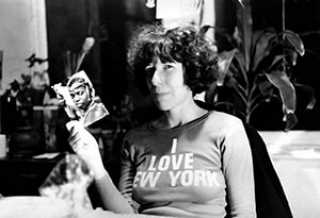Born 1940, San Francisco, California
Mary Heilmann grew up primarily in San Francisco, where the Beats exercised an early influence on her sensibility. After studying poetry and literature, she earned a master’s degree in ceramics and sculpture from the University of California, Berkeley, in 1967. Moving to New York the following year, Heilmann found herself doubly isolated, as a woman and a West Coaster, which led her to stubbornly embrace painting despite the relative marginality of the medium by the end of the decade. Between 1975 and 1981 she showed with the Holly Solomon Gallery, the bastion of the pattern and decoration movement. In 1986 she became the only woman represented by the Pat Hearn Gallery, the center of the East Village art scene at the time. It was her 1990 survey at the Institute of Contemporary Art, Boston, however, that raised her profile beyond a dedicated circle of artist admirers.
At Berkeley, Heilmann had gravitated to both Bruce Nauman’s poststudio practice and David Hockney’s arch approach to painting. After exploring sculptural treatments of unstretched canvas, she began to make more traditional paintings, which are characterized by an emphasis on process and physicality that derives from her background in ceramics. Around 1978 Heilmann began to embrace literary associations in her works, evoking personal memories and subcultural or musical signifiers through her palette and titles. She further foregrounded the allusive quality of her otherwise abstract works in talks incorporating projected snapshots and music.
In Ties in My Closet (1972), the titular painted accessories dangle, tonguelike, from a grid of abbreviated black lines, which resemble slits splintering the surface. Heilmann underscores the literal depth of the painting with a wobbling line that frames the composition, digging into the brushy painted surface and extending over the edge of the stretchers. Using both illusion and inventive paint handling, she evokes the materiality of textiles. Orchid Lady of 1994 conjures and transgresses the rational structure of the modernist grid through a spectrum of glowing jewel tones assembled into a tightly woven checkerboard across a shaped canvas, which itself resembles two intersecting squares. Throughout her oeuvre, Heilmann imagines the grid as a structure able to organize its own dissolution into the murky excesses of color, haptic sensation, and sentiment.
Jenevive Nykolak
Armstrong, Elizabeth, Johanna Burton, and Dave Hickey. Mary Heilmann: To Be Someone. Newport Beach, CA: Orange County Museum of Art, with Prestel, Munich and London, 2007.
